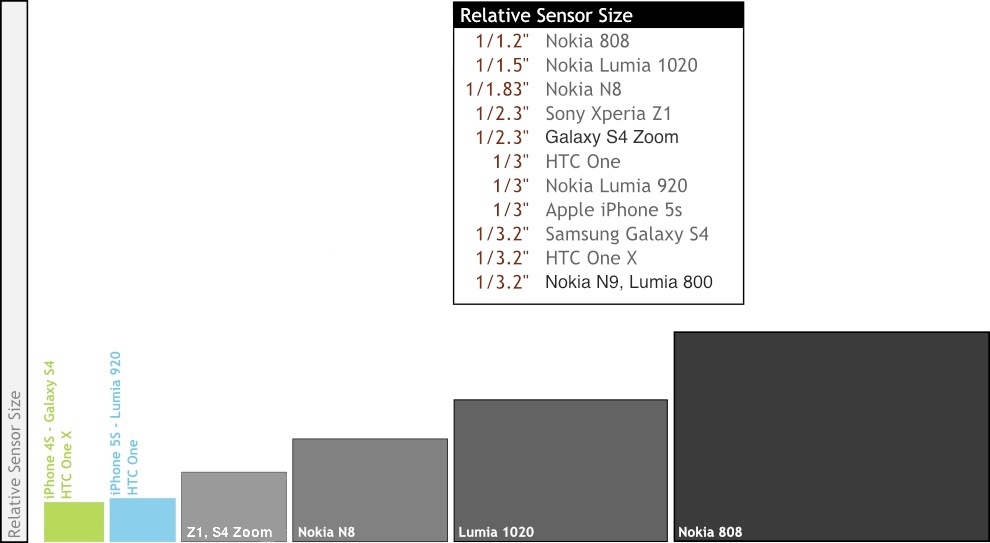The 1/n" optical format specification is all a bit confusing, referring to an obscure equivalence to the 'old' camera world. But the numbers are all relative to each other in the right proportions, of course, with the sensor area of each smartphone camera going roughly as the square of the optical format number.
Don't worry, we've done the maths for you and have represented the sensors graphically below. Your browser will probably downsize the image anyway, so note that the absolute sensor sizes are smaller than they appear on your screen (even the very largest is, in real life, not much bigger than a square centimetre!):

| Compiler's note: we've gathered all known information on the device internals and the information on this page is to the best of our knowledge. However, some stats about some devices are a 'best guess'. Also note that the chart above is diagrammatic and that the exact aspect ratios of each camera sensor may vary slightly. |
The differences in sensor size are quite dramatic - remember that 'square' factor mentioned above? So, for example, Apple made a big thing of making the sensor bigger for the iPhone 5S camera. In the chart, going from the green rectangle to the blue one. Now compare that sensor size to that in the likes of the Nokia Lumia 1020 or 808 and you start to see why the latter two phones keep winning out in camera comparisons when conditions get tough - ultimately, physics/optics play a huge part in how well (phone) cameras perform.
Surprisingly, even the much vaunted 'large' 1/2.3" sensors in the Samsung Galaxy S4 Zoom and Sony Xperia Z1 seem tiny compared to the monster sensors in Nokia's camera flagships.
Now, there's more to camera performance than physical sensor size, of course, which is why more maths is needed. There are other optical factors like aperture size and whether the sensor is Back Side Illuminated. Plus there's the whole image processing chain, converting the raw light input through Bayer filtering, oversampling (if relevant, e.g. on the Nokia 41MP sensor devices and the Sony Xperia Z1) noise reduction, colour corrections and sharpening. And, at the end of all of this, a photo is produced!
The image processing chain varies according to manufacturer, smartphone platform, device and firmware version number, but we can at least get a handle on the raw light gathering ability (LGA) of each smartphone camera with some more maths.
In order to estimate LGA, for each device under consideration, I took the quoted optical format and:
- calculated the approximate sensor size
- factored in the aperture size (depends on F number and camera dimensions)
- factored in whether Back Side Illumination was used
With the (somewhat hairy) maths done, the LGA table for all smartphone cameras considered looks like this (sorted from highest amount of light gathered to least):
| Smartphone | Running OS | Light Gathering Ability (relative) |
| Nokia 808 | Symbian | 25.7 |
| Nokia Lumia 1020 | Windows Phone 8 | 20.3 |
| Nokia N8 | Symbian | 7.6 |
| Sony Xperia Z1 | Android | 6.2 |
| Samsung Galaxy S4 Zoom | Android | 4.8 |
| HTC One | Android | 3.8 |
| Nokia Lumia 920/925 | Windows Phone | 3.8 |
| Apple iPhone 5S | iOS | 3.5 |
| Samsung Galaxy S4 | Android | 2.96 |
| Apple iPhone 5/4S | iOS | 2.7 |
| Nokia N9/Lumia 800 | Meego/Windows Phone 7 | 2.7 |
| Samsung Galaxy Nexus | Android | 1.0 |
| Nokia E7/C7/E6 | Symbian | 1.0 |
(The bottom two rows are provided for perspective only, representing more mundane camera phone hardware!)
As with the graphical chart earlier, the gulf between the two Nokia PureView flagships and the rest is larger than you'd expect. So, even when we factor in aperture and BSI, the Nokia 808 and Lumia 1020 have roughly three times the light gathering ability of their nearest challengers. And note that nowhere in any of this analysis have I mentioned 'megapixels' - the actual resolution that the manufacturer chooses to implement, i.e. how to divide up the sensor, is largely irrelevant for this analysis.
The extra step mentioned above is 'image processing', of course, an amorphous factor which is hard to pin down. Plus there are other factors which you have to take into consideration when trying to decide which smartphone camera is 'better':
- Light conditions for the test photo - if there's plenty of light (e.g. sunny) then the raw LGA (and this entire article!) is fairly irrelevant. In other words, if there are enough photons of light hitting each camera sensor pixel then there won't be any pixel-level digital noise, however small the sensor.
- Whether the shot is indoors under flash conditions and the strength and type of the flash (e.g. LED vs dual LED vs Xenon).
- How tight or wide an angle is being used for the camera optics.
This mass of caveats and extra factors not withstanding, I thought you'd find the comparison chart and table interesting - and hopefully worth bookmarking or sharing.
PS. Watch this space for more real life test photo testing comparisons. Lumia 1020 vs Sony Xperia Z1 is the next big one to look out for.
PPS. Thanks to Manpreet for his help with the graphic.
